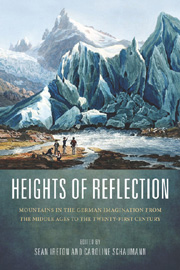 Heights of Reflection
Heights of Reflection Book contents
- Frontmatter
- Contents
- Acknowledgments
- Introduction: The Meaning of Mountains: Geology, History, Culture
- Prelude: Classical Mountain Landscapes and the Language of Ascent
- Part I First Forays: Mountain Exploration and Celebration from the Middle Ages to the Eighteenth Century
- Part II Beckoning Heights: Summits Near and Far in the Nineteenth Century
- Fascinating Voids: Alexander von Humboldt and the Myth of Chimborazo
- From Eros to Thanatos: Hiking and Spelunking in Ludwig Tieck's Der Runenberg
- Geology, Mountaineering, and Self-Formation in Adalbert Stifter's Der Nachsommer
- “An Apparition from Another World”: The Mountains of the Moon and Kilimanjaro from the Perspective of Nineteenth-Century Germany
- Part III Modern Expeditions and Evocations: Climbing from the Twentieth into the Twenty-First Century
- Works Cited
- Notes on the Contributors
- Index
“An Apparition from Another World”: The Mountains of the Moon and Kilimanjaro from the Perspective of Nineteenth-Century Germany
from Part II - Beckoning Heights: Summits Near and Far in the Nineteenth Century
Published online by Cambridge University Press: 05 February 2013
- Frontmatter
- Contents
- Acknowledgments
- Introduction: The Meaning of Mountains: Geology, History, Culture
- Prelude: Classical Mountain Landscapes and the Language of Ascent
- Part I First Forays: Mountain Exploration and Celebration from the Middle Ages to the Eighteenth Century
- Part II Beckoning Heights: Summits Near and Far in the Nineteenth Century
- Fascinating Voids: Alexander von Humboldt and the Myth of Chimborazo
- From Eros to Thanatos: Hiking and Spelunking in Ludwig Tieck's Der Runenberg
- Geology, Mountaineering, and Self-Formation in Adalbert Stifter's Der Nachsommer
- “An Apparition from Another World”: The Mountains of the Moon and Kilimanjaro from the Perspective of Nineteenth-Century Germany
- Part III Modern Expeditions and Evocations: Climbing from the Twentieth into the Twenty-First Century
- Works Cited
- Notes on the Contributors
- Index
Summary
My novel Usambara (2007) deals with Kilimanjaro and the Usambara violet, with Hans Meyer, whose ascent of the mountain in 1889 was most likely the first, and with his secretary and botanist Leonhard Hagebucher. In my book I alternately employ “Mountains of the Moon” and “Moon Mountain” as synonyms for Kilimanjaro, but at the same time I emphasize that these are in the end misnomers. When, in February of 2004, I took part in a trekking tour to the top of the highest peak on the African continent for the purposes of researching my novel, I was unaware of these outdated geographical designations. However, in the course of my hike, the associations with our lunar satellite became readily apparent: the vast wasteland of rock above 5,000 meters reminded me, in its barrenness, of photos taken of the moon's surface. I incorporated this observation into my novel, for instance when one of the other main characters, Fritz Binder, who intends to climb Kilimanjaro one hundred years after his great-grandfather Hagebucher, notes: “So stelle ich es mir auf dem Mond vor. Trostlos. Hässlich. Eine Geröllhalde” (This is how I picture it on the moon. Desolate. Ugly. A huge pile of scree).
While composing Usambara I came upon another, far less personalized, use of the term “Mountains of the Moon.” This appellation dates back to antiquity and was for instance propagated by Claudius Ptolemaios (Ptolemy), whose principal work The Geography (circa 160 CE) synthesizes the geographical knowledge of the era.
- Type
- Chapter
- Information
- Heights of ReflectionMountains in the German Imagination from the Middle Ages to the Twenty-First Century, pp. 210 - 228Publisher: Boydell & BrewerPrint publication year: 2012
